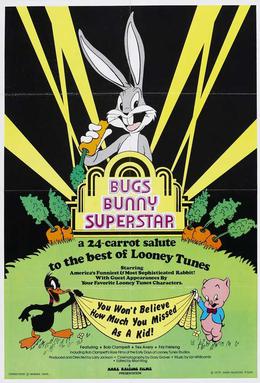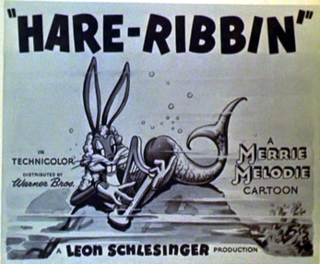Plot
This cartoon opens with the title credits over the strains of “Down by the Riverside”, then into an extended series of establishing shots of an Army Air Force base, to the brassy strains of “We’re in to Win” (a World War II song also sung by Daffy Duck in Scrap Happy Daffy two months before). The sign at the base reads "U.S. Army Air Field", and below that is shown the location, the number of planes (which include C-45 Expeditors and a Douglas B-18 Bolo) and number of men, all marked "Censored" as a reference to military secrecy. Beneath those categories, a sign reads "What Men Think of Top Sergeant", the reply to which is covered with a large white-on-black "CENSORED!!", implying that the language of the men's reply is not suitable for the public (and would not pass scrutiny by the Hays Office).
Bugs Bunny is seen reclining on a piece of ordnance (a blockbuster bomb) idly reading Victory Thru Hare Power (a spoof of the 1942 book). [3] He begins laughing uproariously, and turns to the audience to share what he is reading: an assertion that gremlins wreck American planes through diabolical sabotage (he pronounces those words "di-a-bo-lick-al saa-boh-tay-jee), a notion that Bugs finds ludicrous. As he continues enjoying what he considers a hilarious joke, a little yellow humanoid wearing a large blue helmet with airplane wings scuttles by and begins striking the bomb's nose with a mallet, to the tune of "I've Been Working on the Railroad." It takes Bugs a few seconds to realize the reality of the situation, but shortly he asks the gremlin, "What's all the hub-bub, Bub?"
The gremlin explains that the bomb must be hit "just right" in order to be made to explode and gets back to work. Bugs steps in to suggest that perhaps he ought to "take a whack at it" and proceeds to wind up for a great, hard swing. He stops immediately before making contact, in the sudden realization that, thanks to the strange being, he is engaging in an insane activity. Bugs starts shouting at the creature, but it is apparently gone. Bugs then turns to the audience as he ponders whether he has just had an experience with a gremlin. The gremlin appears on Bugs' face and affirms its existence with a shout, "It ain't Wendell Willkie!" The gremlin, after that, tugs on Bugs' ears and hammers Bugs' foot with a monkey wrench and runs off.
Bugs gives chase and, from its perch on a plane's wing, the gremlin clobbers the rabbit with a monkey wrench, knocking him silly, with Bugs asking, "Which way did he go, George? Which way did he go?" a reference to the 1940 short Of Fox and Hounds, starring Mel Blanc. Bugs then speaks nonsensically as Lennie Small, then as Baby Snooks. When he regains his senses, the now-infuriated Bugs gives chase, wielding the monkey wrench and ending up inside a plane (which ironically resembles a Heinkel He-111). The gremlin grabs the wrench and bashes Bugs' foot with it. As Bugs reacts to the pain, the gremlin locks him in, sets the plane in motion and ultimately into the air. Bugs looks for the gremlin and ends up getting kicked by it - reacting to the creature briefly laughing to the tune of "Yankee Doodle" when it appears at the door's window - is not aware that the plane is aloft until the gremlin opens the door as Bugs comes at it full-throttle, hoping to break it open. The rabbit finds himself in midair and, after turning into a jackass (the comedy trope for being foolhardy) for a moment (as the "You're a horse's ass" motif is heard), he briefly demonstrates a heretofore-unseen ability to fly like a bird before racing through the open sky, back into the plane. Due to strategically placed banana skins, however, he slides out the door on the other side.
The gremlin, believing that his job is done, slams the door triumphantly but opens it again when he notices it shaking. A terrified Bugs is plastered to it, with his heart pounding "4F" (Army code for drastically limiting medical condition, hospitalization required, and/or ineligible to be inducted via the draft). [4] The gremlin pries him from the door; Bugs flies off but soon settles, curled up and flat, on the bomb bay doors - which, of course, the gremlin opens. Fortunately, Bugs' feet catch on a wire but as he is hanging there, he sees that the gremlin is now steering the plane into a city and toward two skyscrapers. Bugs rushes into the cockpit, takes control of the airplane, rolls it vertically, and flies through an extremely narrow slot between the towers to avoid what seemed to be an inevitable impact.
The plane goes into a steep nosedive, its wings ripping off during its descent, and an air speedometer showing: "INCREDIBLE, AIN'T IT???". Bugs is helpless, airsick and melting with terror. The gremlin nonchalantly plays with a yo-yo while awaiting impact. An impossibly short distance above the ground, the plane unexpectedly sputters to a halt and hangs in the air, defying gravity. Both Bugs and the gremlin casually address the audience. The gremlin apologizes for the plane's fuel depletion, while Bugs points to a wartime gas rationing sticker on the plane's windshield and remarks, "Yeah. You know how it is with these A cards!" [3] [5]
















